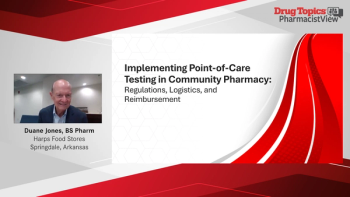
A panelist discusses how point-of-care testing can increase pharmacy revenue through the tests themselves and related OTC product recommendations, and by attracting new patients who were not previously customers.

A panelist discusses how point-of-care testing can increase pharmacy revenue through the tests themselves and related OTC product recommendations, and by attracting new patients who were not previously customers.

A panelist discusses how developing relationships with legislators and presenting data on health care cost savings can help pass legislation supporting pharmacist-provided clinical services, including point-of-care testing.

A panelist discusses how medication synchronization programs are essential for implementing point-of-care testing by making half of prescription volume nonurgent, allowing pharmacists to delegate work and free up time for clinical services.

A panelist discusses how implementing point-of-care testing can help create a formal structure for pharmacists to be recognized as providers who can help reduce health care costs by offering accessible care options.

A panelist discusses how medical billing for point-of-care testing represents a significant revenue opportunity for pharmacies. Further, though the process will be initially unfamiliar, pharmacists should learn and control it rather than outsourcing it.

A panelist discusses how transforming pharmacy staff roles by training technicians to handle clinical programs such as point-of-care testing creates a more efficient workflow system, similar to how physicians work with nurses.

A panelist discusses how obtaining a Clinical Laboratory Improvement Amendments (CLIA) waiver is an essential regulatory step for pharmacies to perform point-of-care testing, followed by credentialing with payers to receive reimbursement for these services.

A panelist discusses how implementing point-of-care testing in community pharmacies can be a significant revenue driver while creating a destination point for patients to receive health care services, especially in areas with limited access to providers.